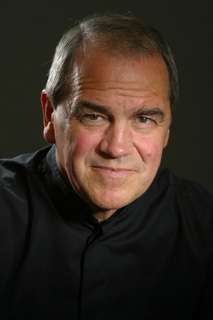|
Back
Double Take Houston
Jones Hall
01/12/2013 - and January 13*, 2013
Aaron Copland: Quiet City
Henri Dutilleux: Symphony No. 2, "Le Double"
Antonín Dvorák: Symphony No. 9 in E Minor, Op. 95 "From the New World"
Adam Dinitz (English horn), Mark Hughes (trumpet)
Houston Symphony, Hans Graf (conductor) 
H. Graf (© Christian Steiner)
The media lead-up to the current Houston Symphony offering repeatedly emphasized the three works' "American" connections. While certainly clear in the case of Copland's Quiet City, the other works on the program, although circumstantially linked to the USA, could not be clearer examples of their composers' individual languages. Dvorák and Dutilleux both ooze the characteristics that have become associated with their respective countries and, with the two works featured on this program, those characteristics are cast in that most "European" of genres: the symphony. The audience members that might have been led to believe that they were going to hear three works that shared many similarities were probably struck by the worlds of difference in the works they encountered.
The idea of doubles or shadow figures is shared between the Copland and Dutilleux works that made up the first half of the evening. Graf and the strings of the Houston Symphony etched Copland's austere masterpiece with utmost precision. They provided an excellent foundation for the two soloists, who played wonderfully. Mark Hughes' first trumpet entrance convincingly communicated Copland's strange "nervous" indication, and his silken legatos ebbed and flowed nicely, while the climactic passage of the piece brought clarion tone and accuracy in the instrument's upper register. English hornist Adam Dinitz was Hughes' perfect foil, predicating and commenting upon the trumpet's entries with gorgeous tone and thoughtful phrasing.
Hans Graf was at his most engaging and informative in a brief introduction to the Dutilleux symphony, complete with smartly chosen musical examples played by the orchestra. Indeed, the audience was drawn in by his guiding hand, and Graf led an excellent interpretation of this elegantly complex work. A hazy Parisian patina hangs over the entire affair, and the orchestra's strings adopted a more transparent tone in their opening hazy chords that encircle the clarinet's ascending ripples. The piece's harder edges were excellently handled by the heavy brass. The dozen soloists that made up the chamber orchestra played with utmost finesse and virtuosity, especially Mr. Hughes' masterful playing of the wonderful solo at the climax of the second movement. Graf was at his most focused in the lengthy, static coda of the finale, which often threatens to outstay its welcome. With a perfectly gradated morendo, the passage seemed an inevitable withdrawal from a fantastic world of sound. The response to the work confirmed that Dutilleux's essay was a pleasant surprise for the audience.
The return to a warhorse after intermission seemed to take the wind out of Graf's sails, however. For the most part, we were given a soporific "New World," defeated by lackadaisical tempos and grossly exaggerated slowing at the second themes of both the first and last movements. Likewise, the third movement simply wasn't "Molto vivace" and lacked rhythmic momentum. Tempo wasn't the only issue in these three movements, however. The motto theme of the work was pregnantly legato and unnecessarily highlighted each time it came around, as if Graf was spoon-feeding the audience that this is a cyclical work. Fortunately, the famous second movement Largo saw a return of focused interpretation from the podium, and a return of Mr. Dinitz's excellent English horn playing. The music also reignited late in the finale (after the fanfare from the two horns), ushering in a glorious, exciting coda.
Marcus Karl Maroney
|